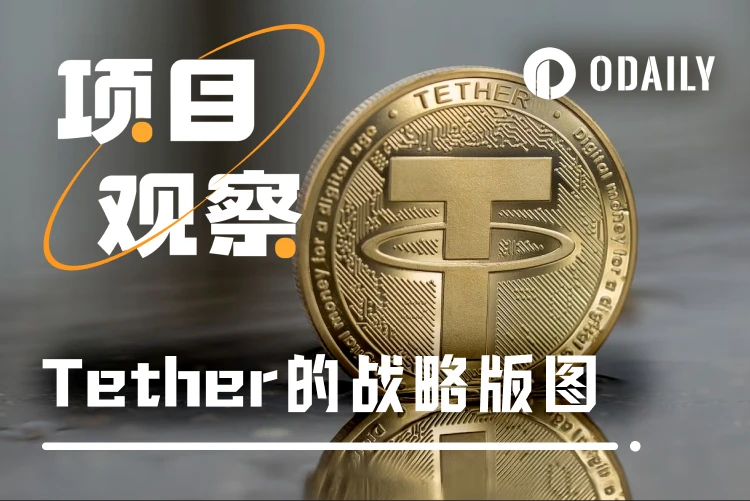Original | Odaily Planet Daily ( @OdailyChina )
Author: Azuma ( @azuma_eth )

Tether, the absolute leader in the stablecoin sector, has been making frequent moves recently. Not only has it made successive moves in vertical cryptocurrency fields such as mining, exchanges, Layer1/Layer2 , but it has also been actively deploying in industries such as AI, brain-computer interfaces, agriculture, and sports.
Although Tethers business has not been limited to the stablecoin sector in the past few years, its layout has accelerated significantly recently. The reason is that with the step-by-step advancement of the GENIUS Act, stablecoins are gradually being integrated into the mainstream financial market in a compliant manner. However, since Tether and USDT are difficult to meet the requirements of the GENIUS Act for the registration of issuing institutions, reserve asset types, audit standards, etc., their market position is bound to be impacted in the subsequent compliance process. Against this background, Tether seems to be somewhat anxious, and the recent multi-directional accelerated layout may be Tethers attempt to break through.
Tether faces challenges amid compliance trend
Earlier this month, the highly anticipated stablecoin regulatory bill, the GENIUS Act, officially passed the final vote of the Senate and was sent to the House of Representatives for deliberation.
The GENIUS Act was first proposed in February this year by U.S. Senators Bill Hagerty, Tim Scott, Kirsten Gillibrand, and Cynthia Lummis, with the aim of establishing a legal framework for the legal use of stablecoin payments in the United States.
The core provisions of the Act are as follows:
Definition of payment stablecoin : A digital asset anchored to a fixed currency value, fully backed by US dollars or other highly liquid assets at a 1:1 ratio, and specifically used for payment settlement scenarios.
Dual licensing regulation : federal regulation, issuers with a market value of more than US$10 billion must be subject to federal regulation; state regulation, small issuers can choose state registration (must meet federal equivalent standards).
100% reserve requirement : Reserve assets are limited to cash, short-term US Treasury bonds or central bank deposits, and must be isolated from operating funds. Proof of sufficient reserves must be submitted monthly to ensure that users can redeem at face value.
Transparency and mandatory disclosure : Reserve fund composition and redemption policy are disclosed regularly and audited for compliance by a registered accounting firm.
Anti-Money Laundering Compliance : Issuers are brought under the jurisdiction of the Bank Secrecy Act and are required to fulfill financial institution-level AML obligations.
Priority protection for users : When the issuer goes bankrupt, the claims of stablecoin holders take precedence over other claimants.
Clear regulatory authority : It is clearly stipulated that payment stablecoins do not fall into the category of securities, commodities or investment companies, thus clearly defining the regulatory boundaries.
In short, as the first federal-level stablecoin bill, the market generally believes that the GENIUS Act will help stablecoins get out of the wild growth stage and formally integrate into the compliant market. But at the same time, the GENIUS Act also imposes strict compliance requirements on existing stablecoin issuers. Among them, USDT, which is registered overseas, has relatively complex reserve assets (part of which is Bitcoin and gold), and has long refused to disclose complete audits, is likely to be hit the hardest.
In an interview with Forbes, Tether CEO Paolo Ardoino said that the company plans to issue a new compliant stablecoin in the US market, which will be tailored for the highly banked and digitalized US economy. However, this may be just a compromise for Tether to deal with the trend of stablecoin compliance in the United States. After all, USDT is Tethers core product, and USDT will foreseeably face greater competitive pressure in the near future, which is obviously not good news for Tether. WSJ has also previously reported that the compliance requirements of the GENIUS Act may cause Tether to become the biggest loser.
Similar situations are not limited to the United States. In February this year, the EUs Markets in Crypto-Assets Regulation Act (MiCA) released a list of compliant stablecoin issuers, including Tethers biggest competitor Circle (USDC issuer). A total of 10 institutions were licensed, but Tether was not on the list.
Under heavy pressure, Tether accelerates its layout
The storm is coming, and Tether will not sit and wait for death. Not long ago, Paolo Ardoino emphasized that Tether will continue to focus its business on markets outside the United States, providing services to 3 billion users around the world who have not yet fully accessed the traditional financial system , and avoiding direct competition between USDT and other stablecoins that are more mainstream in terms of market direction.
At the same time, Tether is also accelerating its layout inside and outside the cryptocurrency industry in order to find new growth points.
According to statistics from Odaily Planet Daily, in 2025 alone, Tether has frequently made moves in cryptocurrency verticals such as mining, wallets, Layer 1/Layer 2, and exchanges through direct entry or indirect investment.
Mining:
In March, Tether announced that it had increased its stake in Bitdeer , with its shareholding reaching 21.4%;
In June, Tether announced plans to open source its Bitcoin mining operating system MOS in the fourth quarter of this year to lower the entry barrier for new miners;
Also in June, Tether announced that the company held a total of more than 100,000 BTC and strived to become the worlds largest Bitcoin mining company by the end of the year .
Wallet:
In January, Rumble, a video-sharing platform invested by Tether, announced that it would launch Rumble Wallet, which intends to use AI agents/assistants to help manage payments;
In February, Tether announced a strategic investment in the self-custodial crypto wallet Zengo to promote Zengos support for Tether stablecoins in the major blockchain ecosystems it covers;
Also in February, Paolo Ardoino publicly criticized MetaMask for being slow, perhaps intending to use it to promote the wallet products he supports.
Layer 1/Layer 2 aspects:
In early June, the Layer 1 project Stable, which is supported by Tether’s investment , was officially launched . Stable will use USDT as its native gas token, and Paolo Ardoino will serve as a consultant for the project.
In mid-June, Plasma, another popular Bitcoin Layer 2 project supported by Tether investment, successfully completed the public deposit stage , and the $1 billion deposit quota was quickly sold out.
Exchanges:
In June, Tether announced a strategic investment in digital asset exchange Orionx, but the specific investment amount has not yet been disclosed.
What is even more surprising is that in addition to frequent moves within the cryptocurrency industry, Tethers layout has long expanded beyond the industry, covering many fields such as AI, brain-computer interaction, agriculture, and sports.
In February, Tether announced that its Tether Data subsidiary is taking the lead in developing BrainOS, an open source platform designed to democratize the use of advanced brain enhancement tools.
In March, Tether announced that it would spend approximately 10 million euros to acquire a 30% stake in Italian media company Be Water, which owns podcast production companies Chora Media, Will Media and film and television production distributor Be Water Film.
In March, Paolo Ardoino published an article on X, emphasizing that Tether plans to recruit talents on a large scale to support the development of its artificial intelligence, telecommunications and data projects.
In April, Paolo Ardoino revealed in his latest interview that Tether plans to launch its own artificial intelligence platform in June (or September) , which will be a peer-to-peer alternative to models such as OpenAI, allowing users to control their own data and perform all reasoning, executing all complex AI logic in their own devices.
In April, Tether announced the completion of its tender offer for up to 49,596,500 common shares of South American agricultural giant Adecoagro SA at a price of US$12.41 per share, for a total amount of over US$615 million.
In May, Tether announced the upcoming launch of QVAC (QuantumVerse Automatic Computer), an intelligent development platform that enables highly scalable AI applications and agents to run directly on local devices without relying on centralized services and cloud infrastructure, thereby protecting users from corporate access to private user data.
In June, Tether announced that it had formally requested to participate in Juventus Football Clubs capital increase plan in May and applied for a board seat. Tether currently holds more than 10% of Juventus Clubs shares and is the second largest shareholder after the controlling shareholder Exor.
In mid-June, Tether announced that it had strategically acquired a stake in Elemental Altus, a publicly traded gold royalty company based in Canada, as part of a strategy to integrate long-term stable assets such as gold and Bitcoin into its ecosystem.
At the end of June, Paolo Ardoino spoke publicly again, saying that Blackrock Neurotech, the brain-computer interface company in which Tether invested $200 million last April, is much more advanced than Musks Neuralink.
Just yesterday, Paolo Ardoino announced that PearPass, an open source password manager developed by Tether, has started testing and will soon be open source on the platform...
The best days are over
With its discontinuity-level advantage in stablecoin liquidity and adoption, Tether, with only 150 employees, achieved a profit of approximately US$13 billion in 2024, making it the most profitable company in the cryptocurrency industry and even the world.
However, the best days are over, and the wild growth stage of stablecoins is coming to an end. In the future, Tether will inevitably face new and old competitors with stronger backgrounds, more thorough compliance, and stricter audits in the market competition.
For Tether, it is time to look to the future, and judging from its recent layout rhythm, it seems to have realized this.










